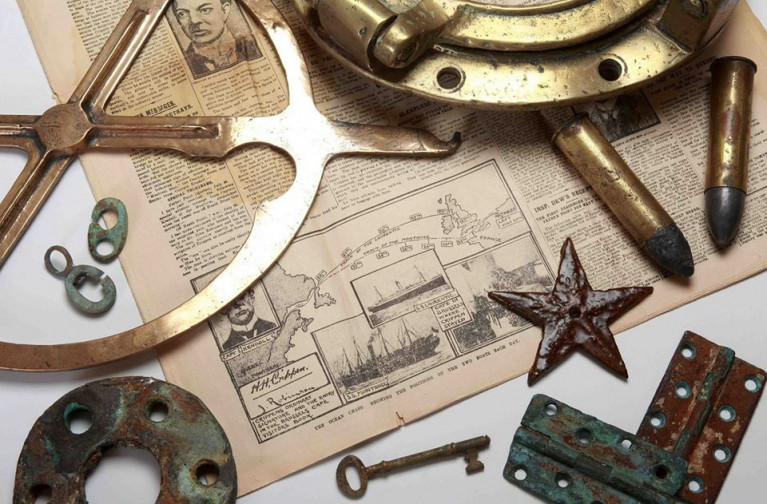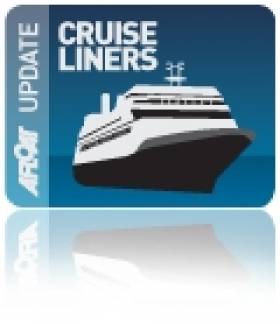Displaying items by tag: DerryLondonderry
Funding of Over £12 million Secured for Derry~Londonderry on the North Atlantic (DNA) Museum
It has been warmly welcomed by members of Derry City and Strabane District Council’s Business and Culture Committee on the news that final Letters of Offer have been received from funding partners for the new Derry~Londonderry on the North Atlantic (DNA) Museum.
The Letters of Offer reports IrelandLive.ie, for the funding came from all the partners for the much-anticipated DNA located in the city’s Ebrington Square, from where the venue has panoramic views of the River Foyle, the Peace Bridge and the Walled City from within the historic Star Fort of Ebrington.
The funding announcement marks a major milestone in the development, and members heard that funding of £12,719,532 has now been allocated and secured from all project partners. The following partners include the Inclusive Future Funding administered through Tourism Northern Ireland (TNI); The Executive Office (TEO); The National Lottery Heritage Fund (Heritage Fund) and Department for Communities (DfC). In addition to funding sources from the Garfield Weston & Galewest Investments Ltd along with the Wolfson Foundation.
The Strabane District Council’s Business Committee received a full report from Council’s Head of Culture Aeidin McCarter, to confirm the news of funding for the DNA as Afloat previously reported and outlined the steps ahead in the delivery of the project.
At the committee, members had heard that officers can now progress with the appointment of an IST (Integrated Supply Team), followed by the Fit-Out contractor, with works at Ebrington Square set to commence on the site in several months’ time, November.
The goal of the £12.7 million project is to have construction and fit-out works completed so that the DNA museum be open in summer 2026, as Ms McCarter confirmed.
More here on the city’s DNA museum.
In Derry~Londonderry the Tower Museum recently released some fascinating new 'online' collections celebrating the north-west city-port and district’s rich maritime heritage.
Detailed diaries from transatlantic journeys and lists of the museum’s archive collection are among the information being made public on the museum’s website.
Bernadette Walsh, Archivist at the Tower Museum, said the archives will allow the public to explore maritime life in the city over the last 300 years.
“Our Maritime Collections are among the most important in the Council’s collection and will be the mainstay of the new DNA Museum at Ebrington.
“We have many archive collections offering unique insights into the importance of the city as an internationally significant port since the 17th century.
“Our shipping archives, in particular those of William Mitchell and Sons, show the importance of the steel hulled barques that set sail from the Foyle around the world, chartering goods as far as Argentina and Australia.
“Other archives give a unique insight into life on the quays, with advertisements for shipping goods, warning signs for theft and poor behaviour as well as beautiful art showcasing the development of the port over the years.
“While we will be showing some of these collections online, we would encourage visitors to our website to download our lists and get in touch if they would like to know more detail.”
The collections will also feature diaries detailing numerous journeys across the Atlantic to the Americas from the viewpoint of a well-known Solicitor, Patrick Maxwell, who lived in the east wall at the turn of the century.
Mr. Maxwell, with a combination of great humour, wit, sincerity and detailed observation, gives a wonderful insight into the trials and tribulations of travelling across the Atlantic on three occasions between 1897 and 1901.
Much of these were published in the 'Derry Journal' but included in his own diaries are photographs of life on board, as well as detailed scrapbooks showing leaflets and souvenirs from his journey.
He describes the people on board, the excitement of travelling, the hardship of poverty and seasickness, culminating in the awe of seeing the lights of New York, Boston and Quebec for the first time.
The collections are available on the museum’s new website: www.towermuseumcollections.com
Ronan McConnell, Tide Project Officer said the Tower Museum plan to further develop these stories in a new visitor virtual experience as part of the TIDE project, funded by Interreg Europe.
“We are excited to also launch our new website,” he added.
“One of the major outcomes for us in the wake of the COVID-19 pandemic and the closure of the museum has been the increased moving of our collections online.
“The fast moving pace of virtual technology is opening up many new possibilities for the public to engage with our collections.
“We are very excited about this and we look forward to sharing more of these collections with the public as we go forward.
“The online material acts as a great resource and complements our new temporary exhibitions, ‘Dividing Ireland’ in the Tower Museum and ‘If Stones Could Speak’ in the Alley Theatre.
“We have also updated our learning and engagement on the new website. Our range of learning programmes help to make local heritage accessible to all, especially our younger citizens.”
The Tower Museum offers a wide variety of packages aimed at Key Stage 2 and 3 which includes guided tours/trails of our exhibitions and workshops. We provide outreach services and educational resources for school.
New learning packs have been developed featuring multiple choice worksheets, for use in the classroom with added activities to make learning fun.
The topics covered are: First World War, Second World War, Armada and Plantation/Siege.
The Community Engagement is available to Voluntary, Community and Statutory Bodies and includes reminiscence through the use of our themed loan boxes.
There is also a dedicated Dementia programme which offers reminiscence sessions, recently developed in partnership with Northern Ireland Museum Council our Love to Move programme, which incorporate exercise and reminiscing for people living with dementia.
The Museum has also developed a Live Well programme which is aimed at Community groups in the Derry City and Strabane District Council area.
This programmes is aimed at the over 50s who do not usually access museums.
The goal is to promote wellbeing through connection to the museum’s collections and through related creative activities, such as glass painting, drawing and decoupage.
#clipperrace – Derry~Londonderry~Doire arrived in Jamaica yesterday to a spectacular welcome as the Northern Irish team continues to threaten the front runners at the top of the leaderboard in the Clipper 2013-14 Round the World Yacht Race.
Derry~Londonderry~Doire crossed the finish line of Race 12 titled race: The Spirit of Jamaica Chase, at Folly Point Lighthouse at 05:31 UTC in ninth place, which is the teams worst result since Race 4 from Cape Town, South Africa to Albany, Western Australia.
After a challenging short 600 mile sprint from Panama to Jamaica, skipper of Derry~Londonderry~Doire, Sean McCarter, said on arrival:
"Race 12 was a lot tougher than expected. We were looking forward to a two or three day hop across the Caribbean but I think it was a lot harder than everybody expected. It was upwind, it was quite bouncy for the first couple of days which isn't very comfortable. It was quite difficult all round. Tactically there two options you could take, we made the mistake of not really committing to either one. Our result shows that unfortunately."
"Everybody is really looking forward to a bit of a rest and it is well deserved. We have a decent amount of time off and we'll be looking to prepare for the next race as everybody is looking forward to getting a more decent result next time around," Sean added.
Henri Lloyd was first across the finish line arriving in Jamaica at 20:41:56 UTC with GREAT Britain right behind in second at 20:42:27 UTC. Switzerland took third place, claiming its second podium finish of the Clipper Race so far, finishing at 21:42 UTC.
Derry~Londonderry~Doire currently lies in fourth place on the overall leaderboard, just seven points behind third place OneDLL and just 15 points behind second place GREAT Britain. With four races still left in the 16 race series and over 60 points still left for the taking the Northern Irish team could still challenge the current overall leader Henri Lloyd for the ultimate prize.
The Clipper Race fleet will be berthed at the Errol Flynn Marina in Port Antonio, Jamaica until 24 May when it will depart in Race 13: The Grange Hotels Trophy to New York which completes Leg 7, the penultimate Clipper Race leg.
Polar Cruiseship Launches London-Derry Port Season
#CruiseNorthWest – Polar cruiseship Fram, a Norwegian-flagged 418 passenger vessel operated by Hurtigruten, became the first visitor this season having docked in Londonderry today, writes Jehan Ashmore.
Fram which has a rather stout looking appearance measuring 114m long, had arrived from Stornoway, Isle of Lewis of the Outer Hebrides. She also presents a striking livery with her black hull separated from her white superstructure by a bold red band.
This colour scheme applies to her fleetmates that are not cruiseships but are essentially multi-purpose vessels that perform the role of carferry, cruiseship and cargo-carrying that 'Hurtigruten' operate daily sailings between Bergen and Kirkenes beyond the Arctic Circle and close to the Russian border.
Fram represents the cruise industry sector to the north-west port which is to welcome a further four callers this season. She is the only cruiseship to berth along the quays of Londonderry, where she docked at the city centre berth.
Two medium sized cruiseships, Delphin and Seabourn Legend are to berth downriver at Lisahally on the east side of Lough Foyle, while on the west coast, off Greencastle, Co. Donegal, the larger Adonia and Crystal Symphony are to make anchorage calls.
Since 1995, Londonderry Port has opened up for business in attracting cruiseships, and among this year's operators are P&O Cruises and Seabourn.
In total more than 4,000 passengers and crew are to visit the city which has hosted in recent years prestigious sailing events, maritime festivals and the high-profile Derry-Londonderry European City of Culture in 2013. This year the city looks forward to Music City 2014.































































